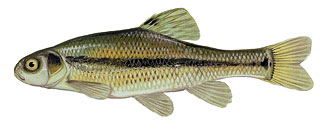Fathead Minnow
Pimephales promelas
 Distribution: The native range of the fathead minnow is west of the Appalachians, through the Great Lakes basin to the Midwest and Great Plain states, and south to Texas and New Mexico. It has been recorded in at least three locations in New Hampshire, Smoky Camp Brook, in Errol, Clough Pond, in Loudon, and French Pond, in Henniker.
Distribution: The native range of the fathead minnow is west of the Appalachians, through the Great Lakes basin to the Midwest and Great Plain states, and south to Texas and New Mexico. It has been recorded in at least three locations in New Hampshire, Smoky Camp Brook, in Errol, Clough Pond, in Loudon, and French Pond, in Henniker.
Description: This is a stout, cylindrical, blunt-headed minnow. The first ray of the dorsal fin is short and thickened. The scales are small and the lateral line is incomplete. Coloration varies from brassy to silvery to almost black, depending on age, season, and sex. Fathead minnow commonly reach 2 to 3 inches in length.
Species commonly confused with: Creek chub, common shiner
Habitat: Often found in large schools in a variety of habitats in lakes and streams. They are tolerant of poor water quality with low oxygen levels, high temperatures, and a wide range of pH levels.
Life History: Spawning occurs from May to August. Eggs are deposited on submerged objects and are guarded by males. The eggs hatch in 5-6 days. Females may spawn several times in a summer.
Origin: Introduced, likely from baitfish importation
Conservation/Management: There are no specific conservation or management objectives for fathead minnow.



